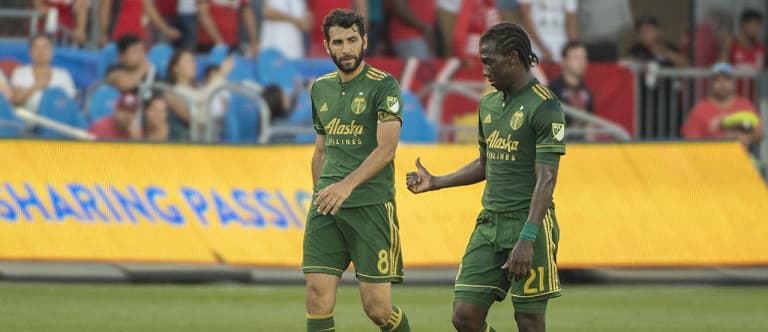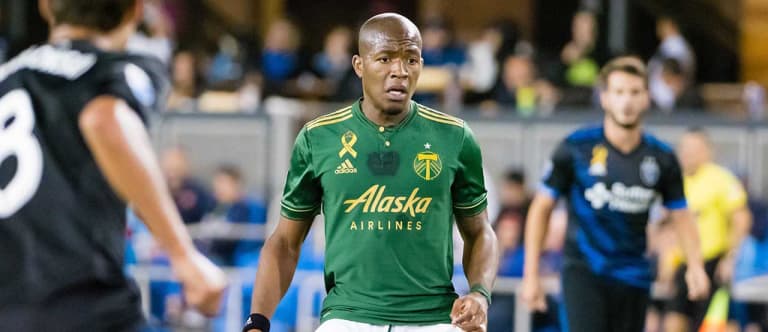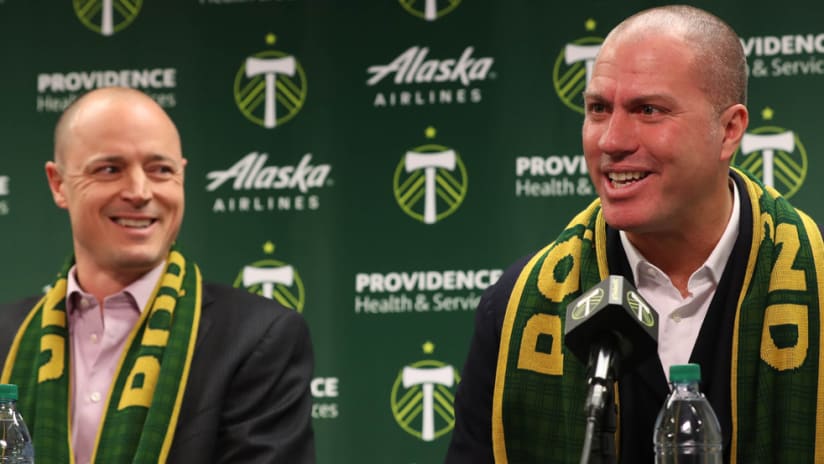This offseason, in the dreary depths of a Portland winter, as they were simultaneously getting over the shock of Caleb Porter’s abrupt departure, making a seismic decision to tradeDarlington Nagbe and conducting an intense search for a new head coach, Timbers owner and CEO Merritt Paulson looked at GM Gavin Wilkinson, haggard from weeks of non-stop work, and told him to go home and get some sleep.
Though Portland had recently finished the 2017 regular season in first in the West before a rash of injuries derailed their playoff hopes in the Conference Semifinals, the club was going through what Paulson called their most “frenetic and hectic” time since the months leading up to their MLS launch in 2011.
One of the faces of the organization, Porter, surprisingly left the team in November. Another, Nagbe, wanted a new contract and, after he and the Timbers couldn’t agree to terms, asked for a trade. Off the field, the club were in the process of expanding their stadium and renovating their training facility.
They still had a talented roster headlined by reigning MVP Diego Valeri and relentless defensive midfielder Diego Chara, but Portland were in a weird spot. Without a coach, with a want-away star player and needing to get younger while still maintaining a strong enough squad to compete for a title in 2018, Paulson and Wilkinson were – quite understandably – under some serious strain.
“That was a deep, deep dive,” Paulson told MLSsoccer.com earlier this week. “It was seven days a week, 12-hour or more days in that period, and especially for Gavin. I was busy and not sleeping during that time, but he was working around the clock. At one point I literally said to him you’ve got to get some sleep, you don’t look healthy, but he eats and breathes this club in a unique way and we felt the pressure.”
A little over six months after all that uncertainty, and Portland are in a good spot. After going winless and bleeding goals on their season-opening five-game road trip, new head coach Giovanni Savarese has the Timbers on an 11-game unbeaten run entering this weekend’s marquee match at fellow Western Conference contenders LAFC. They’re an impressive 8-0-3 in that stretch, third in the West in points per game, have conceded the third-fewest goals in the league and, thanks to offseason additions Samuel Armenteros, Julio Cascante, Cristhian Paredes and Andy Polo, feel like they’re deeper than ever.
The Timbers are quick to point out that they haven’t accomplished anything yet. Their narrative could also feel a lot different at this time next week, after back-to-back matches at Banc of California Stadium on Sunday (6 pm ET | ESPN - full TV & streaming info) and in the U.S. Open Cup quarterfinals on Wednesday.
But for a team that had so much major change this winter, just putting themselves in this position is impressive. Things could’ve easily turned rotten for the Timbers. Instead, they’re off to a strong start, feel have more talent in more places on their roster than at any time in their history and are confident that they’ve started to build a bridge to a new core should Valeri or Chara, both 32, begin to slow down.

Diego Valeri (left) and Diego Chara (right) are key parts of the Timbers' veteran core. | USA Today Images
Paulson, Wilkinson, Savarese and, of course, the players, all deserve a good deal of credit for the Timbers’ upward trajectory. The seeds of their early success, however, date back to that 31-day stretch last winter that began with Porter’s exit on Nov. 17, included the trade of Nagbe to Atlanta on Dec. 13 and culminated with the hiring on Savarese on Dec. 18.
“I’ll say things happen for a reason,” said Paulson. “And it ended up being a really healthy thing for us in a lot of ways. While it was a heck of a lot of work, I think we’ve gotten the club to a really strong spot, with the caveat that we’re not making any proclamations halfway through the season here. There’s a heck of a lot left to do.”
Their work began with a bang last November. Porter’s departure, the reasons for which still haven’t fully emerged, took the entire league by surprise, Paulson and Wilkinson included. That didn’t stop them from immediately diving into their head coaching search, however. Paulson said that they interviewed a number of high-profile candidates,including newly-appointed Orlando head coach James O’Connor, then with USL side Louisville City, and Ajax manager Erik ten Hag, who was then in charge of Eredivisie side Utrecht.
From the moment they first sat down with Savarese, though, they knew he was their guy.
The former New York/New Jersey MetroStars forward and Venezuelan international had a good deal of success with the New York Cosmos in NASL, winning three league titles in five years with the club and developing a reputation as a good man-manager and a coach with an attacking bent. Importantly, according to Wilkinson, his Cosmos played very similarly to the Timbers last season in terms of possession, entries into the final third and where their key players lined up on the field.
“It really was the first time that we sat down with Gio, which ended up being a three and a half or four-hour interview with me and Gavin, and then Gavin spent more time with him and [director of scouting and recruitment Ned Grabavoy] spent more time with him, where we collectively afterwards said, ‘Look, this is going to end up OK,’” said Paulson.

Giovanni Savarese giving instructions to his Timbers players. | USA Today Images
Savarese was the leader from the jump, but the Timbers wanted to do their due diligence and take their time before making a hire. The only problem with that? They also had a roster to manage, an always tricky task that’s immeasurably more complex when you’re doing it without a head coach.
Wilkinson and Grabavoy did have a few things they wanted to achieve over the winter, regardless of who was eventually hired as manager. They wanted to increase the Timbers’ depth, for one, and they wanted to do it in a way that made them younger. They didn’t want to get into a situation where they would have to integrate an entirely new set of important players all at once in two or three years.
The duo had identified Cascante, Paredes and Polo, 24, 20 and 23, respectively, months before Porter left as potential bridges to help Portland avoid an eventual rebuild. They started asking their coaching candidates about them, getting them to share how they saw each target fitting into their system and how they’d like to coach each player, all of whom were eventually signed using Targeted Allocation Money in January.
“We’ve started to try to have a little bit more balance with the group, we’ve tried to look at the age a little bit more, we’ve tried to work on contracts so they are dovetailed so we don’t have three or four key players coming out of contract in the same year,” Wilkinson told MLSsoccer.com. “There was a lot of emphasis on that, there was a lot of emphasis on making sure that the players we’re starting to acquire that we had an internal belief that they could increase in asset value. It was a multi-layered approach.”
The Nagbe situation wasn’t quite as straightforward. From start to finish, it played out much quicker than the Cascante, Paredes and Polo signings. Once it became clear that the US national teamer wanted out of Oregon, Portland got to work exploring their options. They eventually found a willing partner in Atlanta, who sent at least $1.05 million in allocation money – an MLS record – to the Timbers in exchange for the talented midfielder. Though he hadn’t yet been hired, Savarese was made aware of the trade talks and was content with the decision and the return.

The Timbers have managed to account for the loss of star midfielder Darlington Nagbe. | USA Today Images
Ultimately, Wilkinson, whom Paulson praised effusively throughout our interview, said Portland used that money to help land Polo and Armenteros. They didn’t break into the lineup straight away, but that duo, along with Cascante and Paredes, have come on strong during Portland's good run. Polo has perhaps lagged a bit behind the other three, but Wilkinson and Savarese are happy with him. Both said that they’re expecting him to make a leap now that he’s back from World Cup duty with Peru.
Interestingly, three of those four players – Armenteros, Paredes and Polo – were acquired on loan. Armenteros and Polo are both on season-long deals, while Wilkinson revealed that Paredes’ loan runs for two seasons. All of that was by design. Signing them on loan as opposed to bringing them in on a full transfer allowed Portland to spread out their acquisition costs and put them on their budget at a lower overall charge. It also decreases the risk taken on by the Timbers. Instead of guaranteeing more years and more money to any of the players, they can see how they acclimate to MLS, life in Portland and the Timbers organization. If things work well, they’ll try to acquire them permanently when their loans expire.
“I think it’s the basis of the club. It gives us more time to evaluate a decision, it gives us more time to see if the player is going to fit into what we want to do and it commits less resources up front,” said Wilkinson. “What we’re trying to do is stagger the spend and also stagger how we apply our resources, so we can have more balance throughout the group. If we did go out and we did be aggressive, we look to buy Polo or we look to buy Paredes, we would have actually committed more resources up front and could’ve only got one of those players. By actually staggering it out and looking at a loan deal… it helps us manage the resources better and it helps us make more educated decisions.”
Trading Nagbe and structuring those deals as loans allowed the Timbers to make four big offseason additions instead of just two or three. It also gave them the flexibility to be active in the Secondary Transfer Window. It’s been reported that the club will soon add 20-year-old Argentine playmaker Tomas Conechny on loan with an option to buy from San Lorenzo. Former Designated Player Lucas Melano’s loan to Argentine club Estudiantes de la Plata also recently expired, and the Timbers will soon face a decision on whether to bring him back. Both Paulson and Wilkinson also hinted that Portland could sell “a big player” in the near future.
“There’s a couple that could be pretty big,” said Paulson. “I would give you more perspective if something was imminent, but we’ve got one that involves the sale of a big player that won’t happen if the offer doesn’t come through. But if that doesn’t happen, we’ll probably move somebody else or bring somebody back and there’s definitely a couple things that we’re looking at doing. Gavin is juggling all of that.”
“We’ve identified three to four players that we are open to bringing on board,” added Wilkinson. “We’ve gone through the process, we like them, now it’s a matter of making sure we’re not committing too many resources to any one position and making sure that the balance of the group is intact. But then what I would go back to is it’s a domino effect. If we move one player or if there’s a transfer that comes in for one player, then how do we commit those resources to getting better? So, we’re waiting for the first domino to fall and then we’ll react accordingly.”
Even if they weren’t planning on any additions, Portland are in a pretty good spot. After the rough start, Savarese, who Paulson called a “great cultural fit, unbelievably charismatic leader” and “tactically very, very sharp,” put the clamps on, adjusting his system on the fly to a more-defensive 4-3-2-1. The changes have taken, with Portland defending excellently and getting some fantastic goalkeeping from Jeff Attinella to allow just 10 goals in their 11-game unbeaten run. They haven’t always attacked in numbers, but Valeri, fellow DP Sebastian Blanco and Armenteros, who has won the starting striker job from Fanendo Adi, have turned into a three-man wrecking crew on the break. The depth is there, with Adi, midfielder David Guzman and injured defender Liam Ridgewell all looking like they’ll need to work their way back into Portland’s XI once they’re all fully available.
The team is starting to show signs of adding a little bit more, too. They took the game to San Jose in a 2-1 home win on Saturday and have two huge opportunities on deck against LAFC. Even if those don’t go well, the Timbers feel like their roster, coaching staff and front office have added to the foundation constructed in the Porter years. For a team that lost not one, but two club-defining characters over the winter, that’s an accomplishment – even if there’s a lot more left that they want to achieve.
“When you have ambitions to be the best in the league and win Cup, you’ve got to do it well,” said Paulson. “I think that our approach is a pretty healthy, sustainable approach, but we have to get it right. I think we’ve done it somewhat uniquely and I think we need to continue to hit with some of these young guys, but we’re succeeding with the guys we have now and also putting things in place for the future.”













